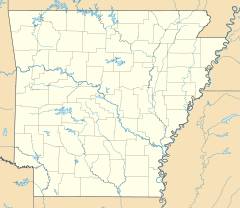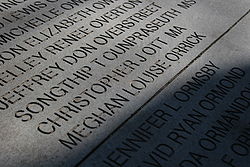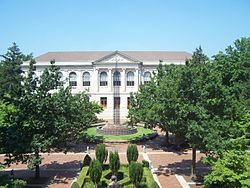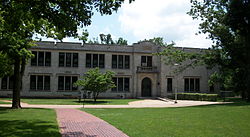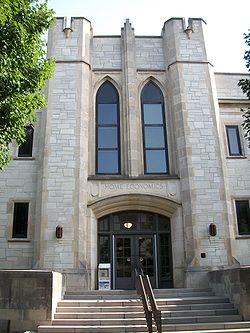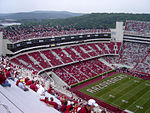- University of Arkansas Campus Historic District
-
University of Arkansas Campus Historic District
Location: Roughly bounded by Garland Ave., Maple St. Arkansas Ave. & Dickson St., Fayetteville, Arkansas Coordinates: 36°4′5.47″N 94°10′19.37″W / 36.0681861°N 94.1720472°WCoordinates: 36°4′5.47″N 94°10′19.37″W / 36.0681861°N 94.1720472°W Area: 71 acres (290,000 m2)[2] Governing body: Private NRHP Reference#: 09000745[1] Added to NRHP: September 23, 2009[1] The University of Arkansas Campus Historic District is a historic district that was listed on the National Register of Historic Places on September 23, 2009. The district covers the historic core of the University of Arkansas campus, including 25 buildings.[2]
The district was added to the National Register of Historic Places (NRHP) on September 23, 2009 and the listing was announced as the featured listing in the National Park Service's weekly list of October 2, 2009.[3]
The historical core of campus was built in many phases, coincident with when funding was available to build. Beginning with the construction of Old Main in 1879, buildings were built haphazardly around campus. This was chenged when the architecture firm Jamieson & Spearl designed the 1925 master plan, which includes many of the Collegiate gothic style buildings (such as the Agriculture Building).[4] The plan allowed for more structure and a better layout. However, funding ran dry and the master plan came to a halt. Building resumed following many Public Works Administration grants after World War II.
Another interesting feature of the campus is Campus Drive. Formerly a through street, Campus Drive was converted to a footpath. It is bounded by many tear-drop shaped lampposts, signifying the Trail of Tears that runs nearby.
Listings
Old Main
Main article: Old Main (University of Arkansas)Old Main, originally University Hall is the University’s signature building and appears on its seal. The building was constructed between 1873 and 1875 as part of a land grant for the state of Arkansas. The building was designed in Second Empire architectural style. The exterior walls are made of local red brick, and the foundation uses local sandstone.[5] John Mills Van Osdel's original plan called for a clock, but one was not installed until 2005.[6] Old Main currently houses the offices of the J. William Fulbright College of Arts and Sciences, its honors program and five academic departments, as well as classrooms and meeting spaces.[6]
Old Main was added to the National Register of Historic Places in 1970
Old Main Lawn
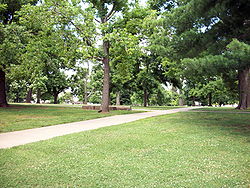 Old Main Lawn near Ozark Hall.
Old Main Lawn near Ozark Hall.
Old Main Lawn is an area surrounding Old Main on the University of Arkansas campus. Prior to 1875, the land was known as the McIlroy Farm. It was purchased for use as a university campus because of its prominence (the campus is still referred to as "The Hill"). The Lawn contains Senior Walk, a concrete walking path that runs throughout the entire campus and contains the name of every university graduate. It also contains Spoofer's Stone, a piece of sandstone that the builders of Old Main left in place after it fell out of an oxcart. The stone was used as a meeting place for males and females before the university became co-ed.[7] The campus arboretum contains every tree found in the state of Arkansas. The Old Main Lawn area was enclosed by sandstone blocks in early 1900.[6]
Senior Walk
Senior Walk is a concrete footpath of over 2.5 miles (4.0 km) started in 1905 that contains the name of University of Arkansas graduates. The idea is unique to the University of Arkansas.[8] Initially, sections of the walk were created by a representative of graduating class who simply wrote the students' names in the wet concrete, the university began using brass letter stamps to imprint the names in wet concrete in the 1920s and continued that process until the late 1970s. The graduating classes prior to 1905 were added retroactively.[6] Larger graduating classes led the university's staff to create the "Senior Sand Hog", which sandblasts the names into the concrete walks after the concrete has cured.[9] For many years, according to university lore, freshmen at university were counseled by upperclass students to not step on the sidewalk bearing the class of 1900, because the members of the 1900 class had all met untimely and tragic deaths. In truth, the members of the class of 1900 lived long productive lives.
The university has designated future sidewalks to continue Senior Walk through at least 2030.
Agriculture Annex
Agriculture Hall was built in 1906 using funding from the Arkansas Legislature. It was one of six other buildings built at the same time. The new Agriculture Building was built in 1927, and the old Agriculture Annex became the university infirmary in 1940.[10] The infirmary moved upon construction of the Pat Walker Health Center. Today, the Agriculture Annex building contains a computer lab for agriculture students in addition to an agriculture statistics lab and offices for graduate students.[11]
Ella Carnall Hall
Ella Carnall Hall
Location: 465 North Arkansas Ave, Fayetteville, Arkansas Coordinates: 36°4′10″N 94°10′8″W / 36.06944°N 94.16889°WCoordinates: 36°4′10″N 94°10′8″W / 36.06944°N 94.16889°W Built: 1905 Architect: James Lambeth Architectural style: Colonial/Victorian Governing body: Private NRHP Reference#: 82000943 [12] Added to NRHP: December 1982 The Inn at Carnall Hall and Ella’s Restaurant are the University’s own on-campus 50-room historic inn and five-star restaurant. This facility also serves the Hospitality and Restaurant Management academic program. Carnall Hall was built in 1905 as the University’s first women’s residence hall.[13] The building was named after Ella Carnall, a noted teacher and role model for young women, and one of the campus’ first female faculty members.[14] It has been renovated into an inn and restaurant.[10] The structure was added to the National Register of Historic Places in 1982.[15]
Construction
The Arkansas Legislature funded six buildings for the University in 1905, one of which was designated to be the first women's dormitory in the state. It was completed by 1906 and named for Miss Ella Howison Carnall, who was a prominent Professor of English and Modern Languages from 1881-84 at the University.[16] The Hall was built on the far northeast corner of campus in keeping with the University's strict rules against fraternization between the sexes.
Uses
The building was used as a women's dormitory until 1967, and then housed the Phi Gamma Delta fraternity until 1977. Subsequently, the Hall was used for academics until the expansion of Old Main. Despite being listed on the National Register of Historic Places in 1982, the building fell into disrepair, and closed in 1991.[17] However, due to the hard work of preservations, the building has been refurbished and today operates as a hotel. It contains over 50 rooms and is very popular during Arkansas Razorbacks sporting events.
Original Chemistry Building
Chemistry Building General information Architectural style Mission/Spanish Location Campus of the University of Arkansas Town or city Fayetteville, Arkansas Country USA Completed 1906 Design and construction Owner University of Arkansas Main contractor Donaghey & McIlRoy Architecture firm C. L. Thompson & O. L. Gates The Chemistry Building was built in 1906 as the original chemistry building on campus. A small, three-story brick building in the Spanish architecture style, it was outgrown and replaced by the new Chemistry Building in 1935. Today this building serves as the Academic Support Building.[18]
Peabody Hall
Peabody Hall General information Architectural style Classic Revival with Mission influence Location Campus of the University of Arkansas Address Maple Street Town or city Fayetteville, Arkansas Country USA Completed 1913 Renovated 1943 Cost $40,000 Design and construction Owner University of Arkansas Architect L.J. Roberts Peabody Hall was built in 1913 using a $40,000 donation from the George Peabody Fund. It was the first on-campus building built using private funds.[18] It was built for use by the Department of Education.
Women's Gymnasium
The Women's Gymnasium was completed in 1925 by the campus Department of Buildings and Grounds with help from the engineering students. The floor was 60 feet (18 m) by 90 feet (27 m), and could hold two basketball counts or four volleyball courts.[18] It also has a full basement.[18] Today, the building is used by the Army ROTC.
Engineering Hall
Hall of Engineering 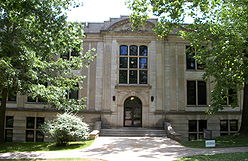
Hall of EngineeringGeneral information Type Engineering education Architectural style Collegiate gothic Location Campus of the University of Arkansas Address Dickson Street Town or city Fayetteville, Arkansas Country USA Completed 1925 Renovated 1951 Design and construction Owner University of Arkansas Architect H. Ray Burkes Architecture firm Jamieson and Spearl Other information Seating type lecture hall Seating capacity 209 Engineering Hall was completed in the collegiate gothic style in 1925.[18] The building was built similar to the Agriculture Building, and was completed at around the same time. Using limestone from Batesville, Arkansas, the building holds an auditorium, library, classrooms, labs, studios, a blueprint room, and a tool room.[18] Following an addition in 1951, and the construction of Bell Engineering Center in 1987, the original Engineering Hall is now used primarily for small classes.
Agriculture Building
Main article: University of Arkansas Agriculture BuildingThe Agriculture Building at the University of Arkansas was completed in 1927 in the collegiate gothic style. The building at first hosted six departments, a library, and offices. The Agriculture Building and Engineering Hall were built at the same time in the same style, as part of the 1925 master plan.[18] Upon completion of the new Plant Sciences building, the original Agriculture Building currently houses the agribusiness and economics, agricultural and extension education, agricultural communications, and entomology departments.
Chi Omega Greek Theatre
Main article: Chi Omega Greek TheatreThe Ohi Omega Greek Theatre is a multipurpose semi-circular amphitheatre, built to replicate the Theatre of Dionysus. Chi Omega donated the theatre to the University, and president John C. Futrall accepted the gift on June 28, 1930, in accordance with the 1925 Jamieson and Spearl master plan.[19] Chi Omega was founded at Arkansas in 1895. It has served host for concerts, pep rallies, commencements, and classes.
Chi Omega Greek Theatre Landscape
The landscape around the Chi Omega Greek Theatre includes shade trees, hedges, and scenic lawns. From the lawn, downtown Fayetteville is visible. The Theatre and Landscape augment each other, together making a historic landscape.[19]
Vol Walker Hall
Main article: Vol Walker HallVol Walker Hall, originally Vol Walker Library was the library on the University of Arkansas campus. Modeled after Rush Rhees Library at the University of Rochester, the University of Arkansas obtained Public Works Administration funding to build the building in the Classic Revival form.[19] The building has also housed the School of Architecture since the construction of Mullins Library in 1968.[19]
Chemistry Building
Main article: University of Arkansas Chemistry BuildingThe Chemistry Building was built in 1935 to replace a smaller chemistry building.[12] It was constructed using Public Works Administration funding in conjunction with Vol Walker Library as part of the 1925 master plan.[18] The university also outgrew this Chemistry Building, and a new building was added by skywalk in 1992.[18]
Gibson Hall
Gibson Hall General information Type men's dormitory Architectural style Collegiate gothic Address Dickson St., and Garland Ave., Town or city Fayetteville, Arkansas Country USA Completed 1937 Renovated 1963, 2007 Cost $165,000 Design and construction Architect Wittenberg & Deloney Architecture firm Jamieson & Spearl Gibson Hall, originally Razorback Hall is a women's residence hall on the University of Arkansas campus. Gibson Hall was originally a men's residence hall, and the three-story brick building was named Razorback Hall. Following a 1963 remodeling, the building became an upper-tier women's dormitory. In 1981, it was renamed posthumously for James L. Gibson, the late University housing director.[20]
Gibson Annex
The Gibson Annex is the accompanying dining hall for Gibson Hall. Originally named Razorback Dining Hall, it was renamed Gibson Annex when the hall was renamed. The dining hall was constructed in the Collegiate Gothic style by Wittenberg & Deloney of Little Rock, completed in 1937.[20]
Former Men's Gymnasium
Main article: Arkansas Center for Space and Planetary SciencesThe Men's Gymnasium was built in 1937 using PWA funds by Haralson & Nelson. Using light brick and limestone, the building was built in the Collegiate Gothic style. It could hold 3,500 patrons as a stadium and 7,500 as an auditorium.[21] It housed Arkansas Razorbacks basketball until the construction of Barnhill Arena in 1954, the physical education department unitl 1982, and the university museum unitl 2003. It now contains the Arkansas Center for Space and Planetary Sciences.[22]
Memorial Hall
Student Union Building-University of Arkansas, Fayetteville
Location: Southeastern corner of the junction of Campus Dr. and Maple St., Fayetteville, Arkansas Coordinates: 36°4′11″N 94°10′15″W / 36.06972°N 94.17083°WCoordinates: 36°4′11″N 94°10′15″W / 36.06972°N 94.17083°W Area: 58,000 square feet (5,400 m2) Built: 1940 Architectural style: Collegiate Gothic (front), Gothic and Classical Revival (remainder) Governing body: University of Arkansas MPS: Public Schools in the Ozarks NRHP Reference#: 92001104 [12] Added to NRHP: September 1992 Futrall Memorial Hall, usually just Memorial Hall, originally Student Union at the University of Arkansas is a building on the University's campus in Fayetteville, Arkansas. The building was added to the National Register of Historic Places in September 1992 as Student Union Building-University of Arkansas, Fayetteville.[23]
History
President John C. Futrall identified a need for a student union on campus and began charging students a $2 "student union fee" on their bill. That fee, coupled with Public Works Administration funding, resulted in the construction of Memorial Hall, which at the time was named Student Union. On September 12, 1939, Futrall was killed in an automobile accident, and the Board of Trustees passed a resolution to change the name to Futrall Memorial Hall. The building was still referred to as the Student Union, despite the motion.
The grand building was opened in March 1940, and featured a bookstore, restaurant, post office, confectionery, and a large ballroom with bandshell.[24] The second floor had offices for The Arkansas Traveler (the student publication). The building remained as it was for ten years, until a large three story addition was finished to provide better food services. Upon completion of the Arkansas Union in 1973, Memorial Hall became home to the psychology department, and many of the rooms were converted to classrooms. It also gained the Landscape Architecture and Air Force ROTC departments.
The Board of Trustees again changed the name to Memorial Hall in 1973, which is how it is known today. The building still houses the three listed departments to this day.
Features
Memorial Hall's interior contains many art deco features from the period of construction, including large lights near the steps of the north enterance and lots of sleek lines. The floors feature repeating patterns typical of art deco contsruction and the staircases appear streamlined and modern. At the west enterance to the building stand two large, mature trees. One is a Bald Cypress and the other a Southern Magnolia. Both trees date to the time of Memorial Hall's construction.[25]
Ozark Hall
Main article: Ozark HallOzark Hall is one of the older buildings on campus. It is home to several of the physical science departments. The building was formerly attached to the Commerce Building, and together the structure was known as the Business Administration Building. The Business Administration department moved out in 1978, and the Commerce Building was razed in 1987.[26] The building is located directly to the south of Old Main.
Home Economics Building
Delta Gamma House
See also: Delta GammaDavis Hall
Geology Building/Ordark Building
Gregson Hall
Holcombe Hall
Pi Kappa Alpha
See also: Pi Kappa AlphaFine Arts Center
Fine Arts Center Landscape
Phoenix House
See also: Sigma NuPhoenix House Landscape
See also
- Campus of the University of Arkansas - lists the thirteen non-contributing buildings on campus and some on-campus monuments.
- History of the University of Arkansas - a complete history of the U of A
- University of Arkansas
- John C. Futrall - University president responsible for the construction of many of the early buildings
- David Mullins - University president responsible for many of the newer buildings listed above
- The National Register of Historic Places - the list this district is listed on
References
- ^ a b "Announcements and actions on properties for the National Register of Historic Places". Weekly Listings. National Park Service. October 2, 2009. http://www.nps.gov/history/nr/listings/20091002.htm. Retrieved October 2, 2009.
- ^ a b Glen Bennett, Rob Yallop, and Ralph S. Wilcox (May 20, 2009). "National Register of Historic Places Registration: University of Arkansas Campus Historic District" (PDF). National Park Service. http://www.nps.gov/history/nr/feature/weekly_features/UnvirofArkansasCampusHD.pdf. Retrieved October 6, 2009. (90 pages, with maps and b&w photos)
- ^ "Weekly List Actions". National Park Service. http://www.nps.gov/history/nr/nrlist.htm. Retrieved October 6, 2009.
- ^ "National Register of Historic Places Registration Form - University of Arkansas Campus Historic District." National Register of Historic Places - National Park Service. [1] Page 8. Retrieved June 23, 2010.
- ^ "National Register of Historic Places Registration Form - University of Arkansas Campus Historic District." National Register of Historic Places - National Park Service. [2] Page 10. Retrieved June 23, 2010.
- ^ a b c d "National Register of Historic Places Registration Form - University of Arkansas Campus Historic District." National Register of Historic Places - National Park Service. [3] Page 11. Retrieved June 14, 2010.
- ^ "Spoofer's Stone." Arkansas Alumni Association. Traditions. Retrieved June 14, 2010.
- ^ "Senior Walk." Arkansas Alumni Association. Traditions. Retrieved June 14, 2010.
- ^ "Senior Walk." University of Arkansas. Senior Walk profile. Retrieved June 15, 2010.
- ^ a b "National Register of Historic Places Registration Form - University of Arkansas Campus Historic District." National Register of Historic Places - National Park Service. [4] Page 12. Retrieved June 15, 2010.
- ^ "History of the Entomology Department". Dale Bumpers College of Agricultural, Food, and Life Sciences. http://entomology.uark.edu/3523.htm.
- ^ a b c "National Register Information System". National Register of Historic Places. National Park Service. 2010-04-12. http://nrhp.focus.nps.gov/natreg/docs/All_Data.html.
- ^ "National Register Information System". National Register of Historic Places. National Park Service. 2010-06-15. http://nrhp.focus.nps.gov/natreg/docs/All_Data.html.
- ^ "One of America’s Historic Hotels." The Inn at Carnall Hall. History. Retrieved June 15, 2010.
- ^ "Carnall, Ella, Hall." National Register of Historic Places. Profile. Retrieved April 12, 2010.
- ^ "One of America’s Historic Hotels." The Inn at Carnall Hall. History. Retrieved April 12, 2010.
- ^ "Inn at Carnall Hall." Historic Hotels. History. Retrieved April 12, 2010.
- ^ a b c d e f g h i "National Register of Historic Places Registration Form - University of Arkansas Campus Historic District." National Register of Historic Places - National Park Service. [5] Page 13. Retrieved June 15, 2010.
- ^ a b c d "National Register of Historic Places Registration Form - University of Arkansas Campus Historic District." National Register of Historic Places - National Park Service. [6] Page 14. Retrieved June 23, 2010.
- ^ a b "National Register of Historic Places Registration Form - University of Arkansas Campus Historic District." National Register of Historic Places - National Park Service. [7] Page 15. Retrieved June 23, 2010.
- ^ "National Register of Historic Places Registration Form - University of Arkansas Campus Historic District." National Register of Historic Places - National Park Service. [8] Page 16. Retrieved June 23, 2010.
- ^ "W.M. Keck Laboratory for Planetary Simulation." University of Arkansas. About Us. Retrieved June 23, 2010.
- ^ "Memorial Hall." University of Arkansas. Profile. Retrieved June 14, 2010.
- ^ "National Register of Historic Places Registration Form - University of Arkansas Campus Historic District." National Register of Historic Places - National Park Service. [9] Page 17. Retrieved June 23, 2010.
- ^ "University of Arkansas Campus Historic District, Fayetteville, Washington County, Arkansas". Arkansas Historic Preservation Program. http://www.arkansaspreservation.com/historic-properties/_search_nomination_popup.asp?id=919.
- ^ "Ozark Hall." University of Arkansas. Overview. Retrieved June 23, 2010.
External links
- "University of Arkansas Historic District Listed on National Register of Historic Places". University of Arkansas. 6 October 2009. http://dailyheadlines.uark.edu/15896.htm. Retrieved 2009-11-01.[dead link]
- "The University of Arkansas". Campus Heritage Network. http://www.campusheritage.org/page/the-university-of-arkansas. Retrieved 2009-11-01.[dead link]
U.S. National Register of Historic Places Topics Lists by states Alabama • Alaska • Arizona • Arkansas • California • Colorado • Connecticut • Delaware • Florida • Georgia • Hawaii • Idaho • Illinois • Indiana • Iowa • Kansas • Kentucky • Louisiana • Maine • Maryland • Massachusetts • Michigan • Minnesota • Mississippi • Missouri • Montana • Nebraska • Nevada • New Hampshire • New Jersey • New Mexico • New York • North Carolina • North Dakota • Ohio • Oklahoma • Oregon • Pennsylvania • Rhode Island • South Carolina • South Dakota • Tennessee • Texas • Utah • Vermont • Virginia • Washington • West Virginia • Wisconsin • WyomingLists by territories Lists by associated states Other Categories:- Historic districts in Arkansas
- Schools on the National Register of Historic Places in Arkansas
- Buildings and structures in Fayetteville, Arkansas
- University of Arkansas
Wikimedia Foundation. 2010.

